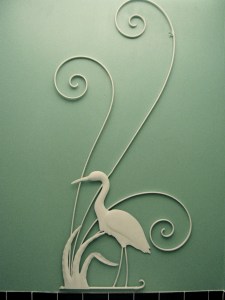 Antiquips Pickin & Grinin
Antiquips Pickin & Grinin
Pick: This is going to be our first article for Inherited Values so let’s show off some of our unusual collectibles.
Grin: How about your hand mirrors? You are always bragging to anyone that will listen, just how great you think they are and how well you display them.
Pick: Oh, I’d like to but I’d have to polish them all before we let a whole group of people in to see the collection.
Grin: Well, what’s your idea then? Or are you just Picking on me because it was my idea?
Pick: Why don’t we start with the smallest room in the house and show readers what can be packed into a tiny area with a little imagination.
Grin: Are you referring to your jewelry box? You sure know how to pack that thing full.
Pick: Boy we’re real smart today. No I’m talking about the powder room at the back entrance, the one that started out with a bare bulb hanging from the ceiling with a pull chain for decoration. Let’s show off our antique finds in that room first. I think we managed to accent the room nicely with some unusual pieces in a space of seven foot by four feet. Plus we did our “green piece” by recycling some items.
Grin: Five feet, it’s no longer than five feet.
Pick: Well, whatever, the important thing is we get to display the oddities within. But just to keep my reputation intact, how about a quick measure to see who is right. I say it’s about seven feet by 3-1/2” feet. What is your best guess?
Grin: I think five feet, maybe by 4-1/2 feet.

Pick: What was the measurement?? Oh, guess you were closest. Now, let’s change the subject. How about we start with the egret, the old screen door decoration. You know, the one I dragged home from an auction and had to listen to your questions like “Now, WHERE can we put that old thing?”
Grin: In this instance, you were right. It fits in flush, right over the toilet, a pun intended!
Pick: Well, if you’re giving me credit, I must say, your cold air return register was a perfect fit. It’s a radio speaker grill from a Pontiac Straight 8, probably from the early 1950s. And it squeezed right into the space.
 Grin: I also recall where we got the old tin sheets that we needed when I dropped the ceiling to update the electricity to enable a wall switch. We had to purchase the full lot of sheets, but only needed a few and sold off the rest at a flea market. Then you found that marvelous iridescent chandelier at a local antique store. You discovered it just in time, too, because we had not decided on the color to paint the room and the green shade enlightened us.
Grin: I also recall where we got the old tin sheets that we needed when I dropped the ceiling to update the electricity to enable a wall switch. We had to purchase the full lot of sheets, but only needed a few and sold off the rest at a flea market. Then you found that marvelous iridescent chandelier at a local antique store. You discovered it just in time, too, because we had not decided on the color to paint the room and the green shade enlightened us.
Pick: Dear, you are funny today – you should be “pun-ished.” And you kept your promise to let me have some stained glasswindows in the house. That was something you committed to when we left our other house that had so many! And you did a super job finding the black and white tiles that are so “1930s”, it really completed the look we wanted.

Grin: Well, let’s continue in another area in our next blog. There’s hardly room for two of us in this room!






























